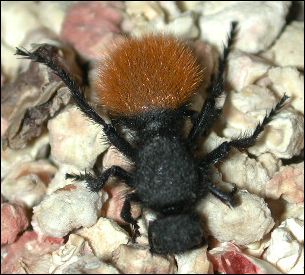

Nature is full of warning signs: the bristling quills of a porcupine, a rattlesnake's buzz, the snarl of a cornered coyote. All say "Back off!", and when animals share the same warning sign, they have a distinct advantage. A predator that learns the warning takes heed regardless of its source.
Sharing is common among animals that depend on warning coloration.
Conspicuous colors, especially patterns of black and white, black and red, or black and
yellow, have one thing in common: they visually shout "danger!" But among
animals, as with most people, there are always those who have to learn the hard way.
For example, it usually takes several encounters with hornets and skunks to learn that
a black and white pattern is shorthand for unpleasant and painful. By sharing a
pattern, the damage received by any one species during the learning process is
alleviated. A predator that requires five unfortunate encounters to learn avoidance
often has killed or injured five individuals while learning—by spreading these damages
among several species, no one population is badly depleted.

Contributor: Arthur H. Harris, Laboratory for Environmental Biology, Centennial Museum, University of Texas at El Paso.
Desert Diary is a joint production of the Centennial Museum and KTEP National Public Radio at the University of Texas at El Paso.

A velvet ant—the red color says "Danger—Back off!" Photograph by A.H. Harris.
Aposematic Light. Young fireflies warn off predators with light.
Wayne's Word. Great photographs of aposematically-colored poison dart frogs.